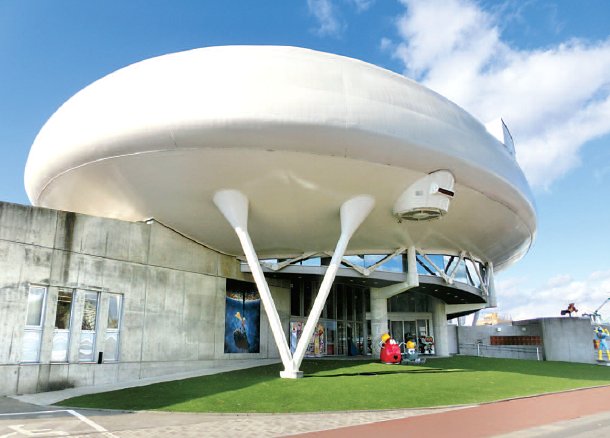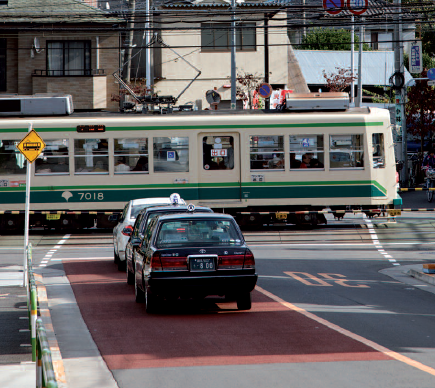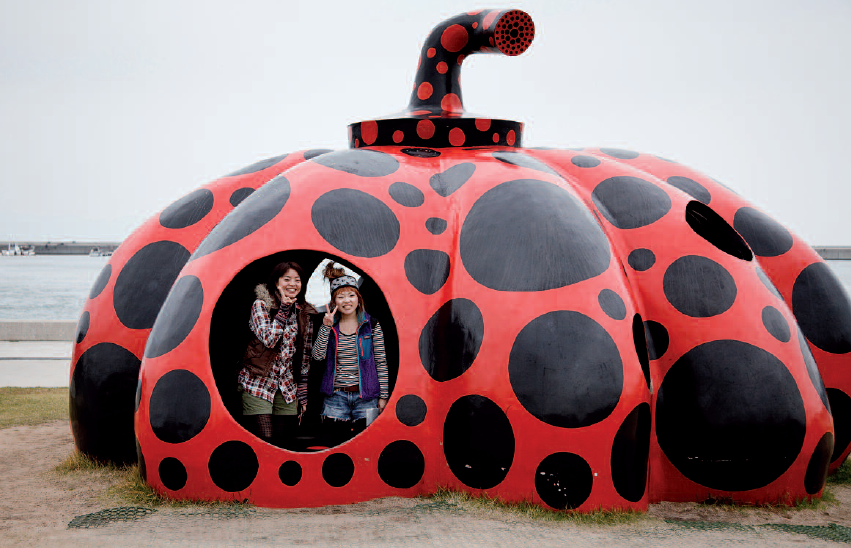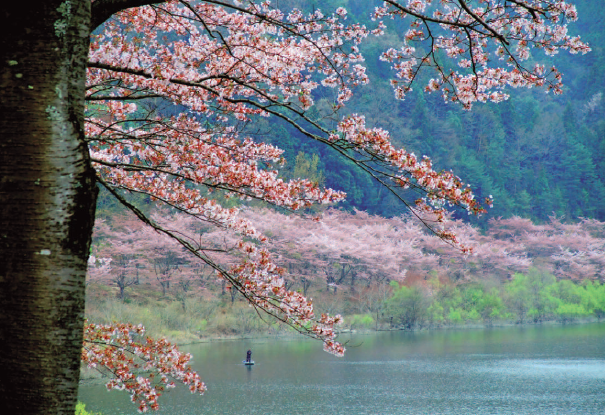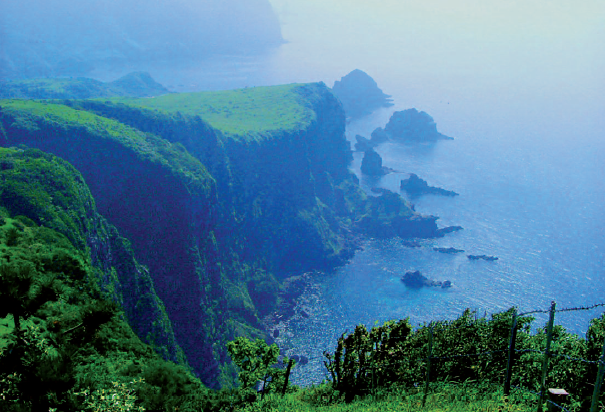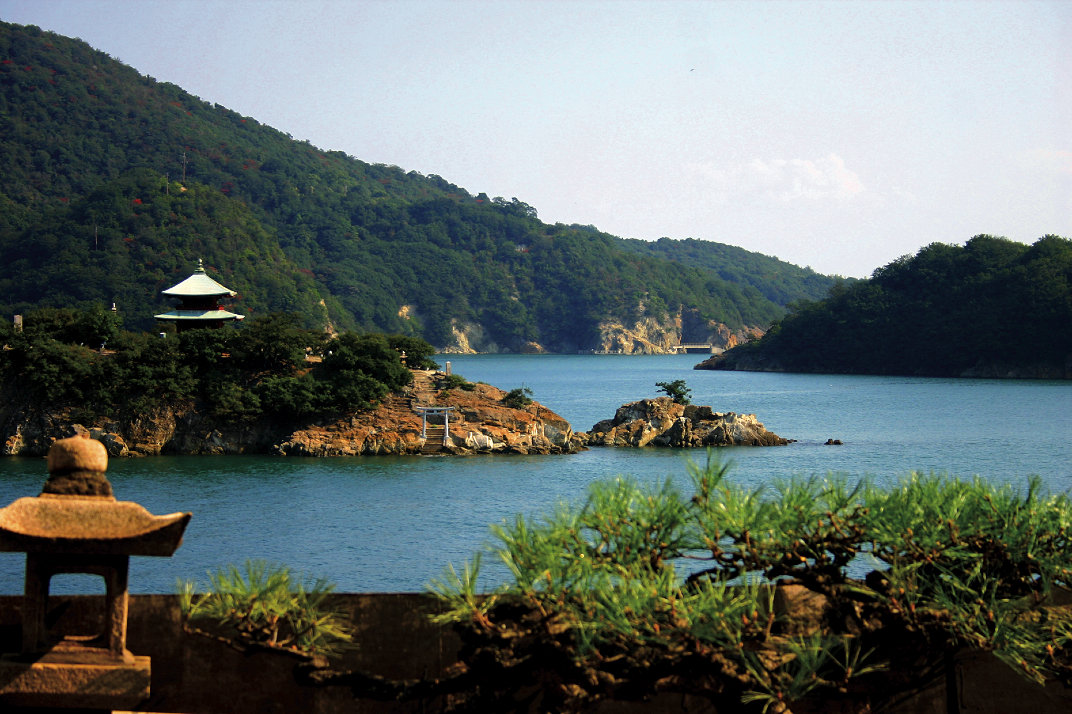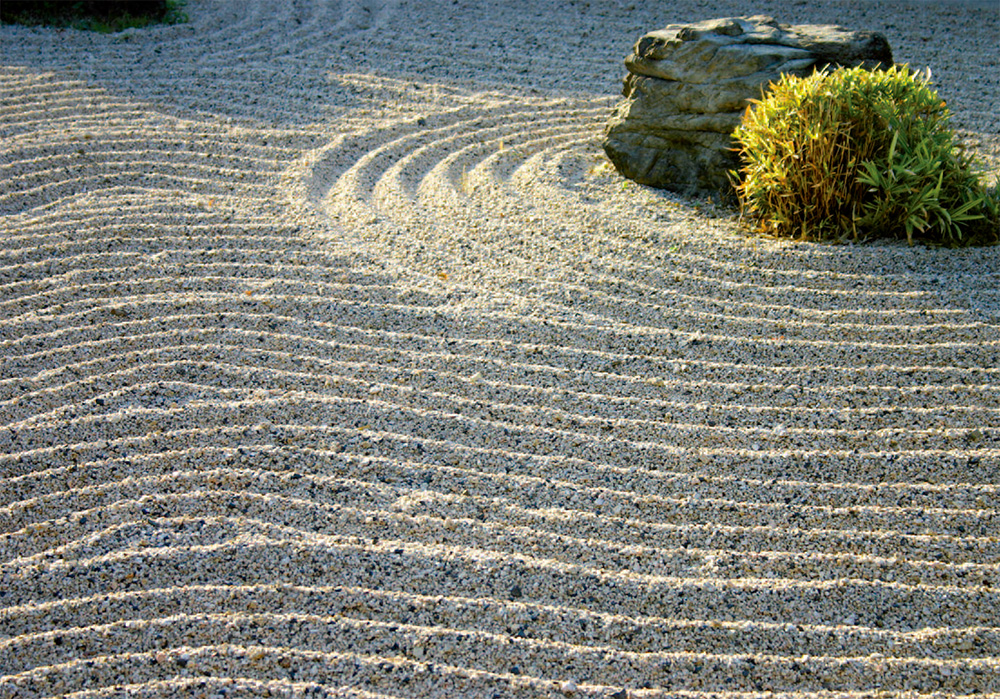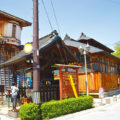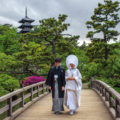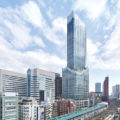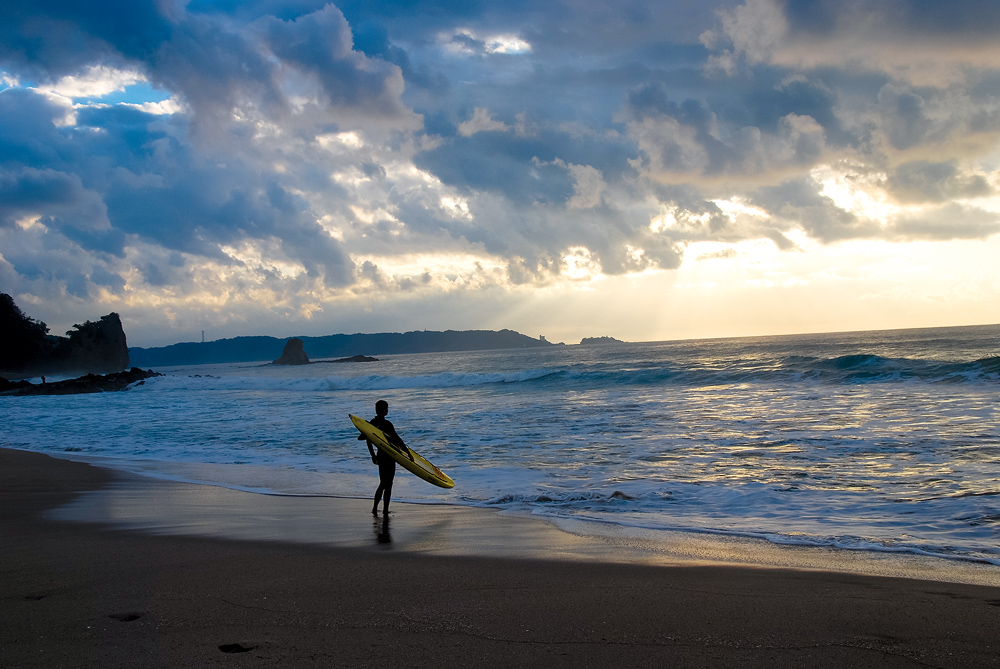

Kisami beach is one of the most popular spots for surfers.
A source of inspiration for the great MIYAZAkIHayao, the Izu Peninsula has plenty of treasures to discover.
The silhouettes of surfers takes shape in the breaking dawn. It’s 5:00 in the morning at the end of August and the sun is rising slowly over the beach at kisami. “I come here every morning before work,” says ARAI Yuko, a friend who came to live in this seaside resort 9 years ago. We admire the glowing red rock emerging from the sea accompanied by an incredible concert of cicadas. There are no souvenir shops or hotel complexes to spoil the scenery. Despite its proximity to Tokyo, kisami has retained its wild charm and its own particular multicultural vibe. In the hills surrounding the bay, traditional Japanese inns contrast with the Victorian-style hotels on the lower slopes. That’s not surprising when you realise that Shimoda witnessed Commodore Perry’s famous fleet of black ships disembark here in 1853, which led to Japan opening its doors to the West and bringing an end to two centuries of autarchy. Located 5 km from kisami on the Izu Peninsular, the town has preserved part of the historic port called “Perry Road” where you can enjoy the old-fashioned charm of traditional houses with namako slate roofs or eat a “Perry ice-cream” on the landing stage. “There have always been a lot of foreigners in kisami, perhaps they are Perry’s descendants,” remarks Yuko, pulling her dog’s lead. Along the only road leading from the beach we pass by an imposing white building, ernest house a nod to hemingway, and one of the oldest hotels in kisami, owned by an American. On a verandah, a Japanese-American family is eating breakfast consisting of club sandwiches, coffee and muesli. “There’s more Western food eaten in kisami than Japanese, but I know the perfect place for a traditional Japanese breakfast,” Yuko assures me, taking me to Tobiishi a little further on. It opens at 7:00 and there’s already a large table of tanned, greying surfers in the small Japanese shop. On the menu there’s grilled Japanese mackerel, natto (fermented soya), miso soup… and some good refreshing beer. Calls of “kanpai!” resound round the room. Despite the sea air, it’s already scorching hot by 8:00. “for coffee, you must go to ernest’s!” explains manager hATTORI Chioko, smiling broadly. for the past 40 years she and her husband have opened this shop from July to September. She brings us two more breakfast platters, “also served at lunchtime and in the evening”, before going back to the kitchen. Though her back is bent from long hours working over the stove, she still has boundless energy, no doubt inspired by the mantra prominently displayed in the room and which can be translated as “Never tire of your trade”. “A surfer from kisami went to help people in Sendai after the tsunami in March 2011. he brought back this simple piece of calligraphed cotton, and told me that a restaurant owner from the region had hung it in his restaurant and his business had subsequently miraculously flourished!” she confides. The customers laugh heartily. Some of them have been coming to this family canteen, a veritable kisami institution, for the past twenty years. Next to the calligraphy, there’s a faded poster of a lady basking outdoors in one of the peninsular’s famous thermal springs. “Due to the coronavirus many of the hot springs are closed, but there’s a small public bath at nearby Yumigahama Beach,” Mrs hATTORI advises us. A group of female surfers comes in to ask for information about the public shower. “It’s closed! The authorities asked for it to be disinfected each time it was used, an impossible task for the owner,” explains the restauranteur, regretfully. “That’s a bit much!” comments one of the customers.
A couple of Americans come in to pay for parking and request information. “They are corona refugees,” whispers Mrs hATTORI. According to her, many foreigners have fled the capital since the start of the pandemic and settled locally. Yuko, who runs a small private bar in kisami, nods her head in agreement. “The houses around kisami have been under siege,” she assures us. The fan stirs up the increasingly hot air. Then, A source of inspiration for the great MIYAZAkIHayao, the Izu Peninsula has plenty of treasures to discover. Kisami beach is one of the most popular spots for surfers. The Castle in the Sky is here! Alissa Descotes-Toyosaki for Zoom Japan March 2021 number 84 ZOOM JAPAN 21 TRAVEL out of the blue it starts to rain heavily while the sun continues to shine. Mr hATTORI emerges from his reverie. “It’s the time when foxes marry their daughters,” murmurs the old man. he looks up to the sky from behind his glasses with a kindly expression before once again immersing himself in his newspaper.
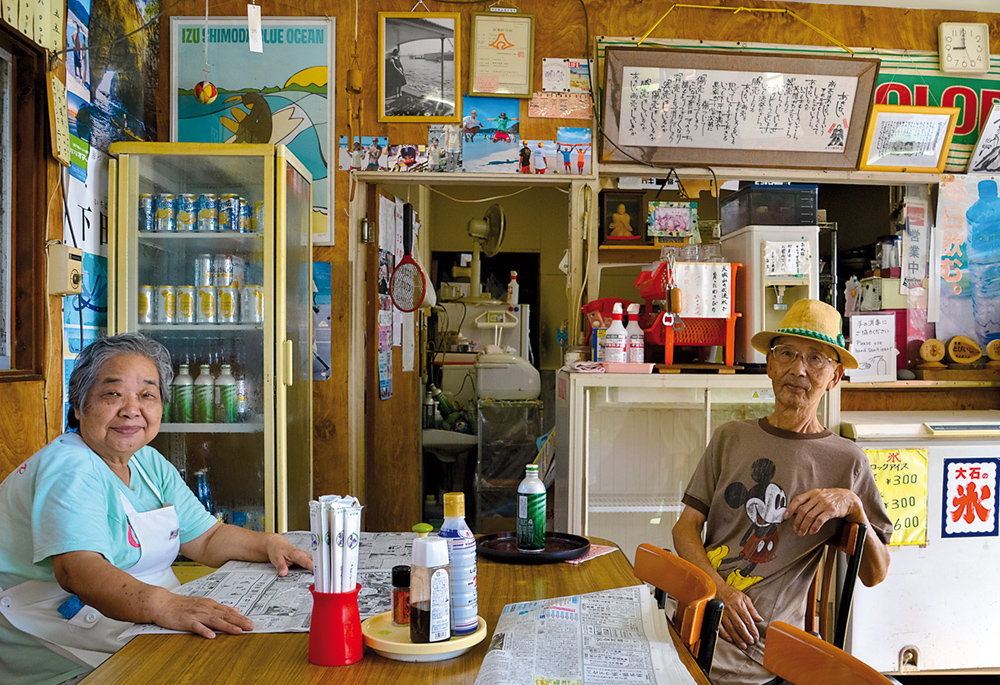
The owners of Tobiishi serve mouth-watering traditional breakfasts.
We leave, heading towards the sea through the little tunnel that runs along the hillside. Around 10:00, the beach is invaded by a much more summery crowd of people. families have came to spend the day in the shade of the large rock and they set up tents, cool boxes and deckchairs. A man wearing a pink thong walks along with women in leggings and socks, a couple in duckshaped rubber rings float in an area of water designated safe for bathing. “Watch out! Don’t go too far!” shouts a loudspeaker to the bathers with their rubber rings. Overly cautious maybe, but justified, according to the authorities, due to the the number of people who drown every year and the presence of the kuroshio, the second strongest ocean current after the Gulf Stream. Carrying warm water from the south towards the polar regions, the kuroshio feeds into waters rich in corals, fish and sharks. “You see that island over there, every year at this time, shoals of hammerhead sharks arrive,” says Yuko, pointing to Mikomoto, an inhabited island just 10 kilometers from the beach. It’s a very popular spot for diving enthusiasts. On the horizon you can see the cone of Toshima, one of the hundred islands of the Izu archipelago which spread out towards the south. The Izu Peninsula is said to be the only place in the world where two active volcanic arcs have been colliding for 20 million years. This intense activity has led to uNeSCO classifying several sites on the peninsula as Global Geoparks because of their exceptional geological heritage. One of these sites is just a few kilometres from kisami Beach: Ryugyu Cave, whose 40 meters wide skylight and heart-like shape attracts numerous tourists. Though it has been somewhat damaged by recent typhoons, the site offers other attractions such as the sand ski resort, a natural 30 degree slope descending almost into the sea, and a delightful shrine overlooking the ocean where you can go to pray for the sea gods.
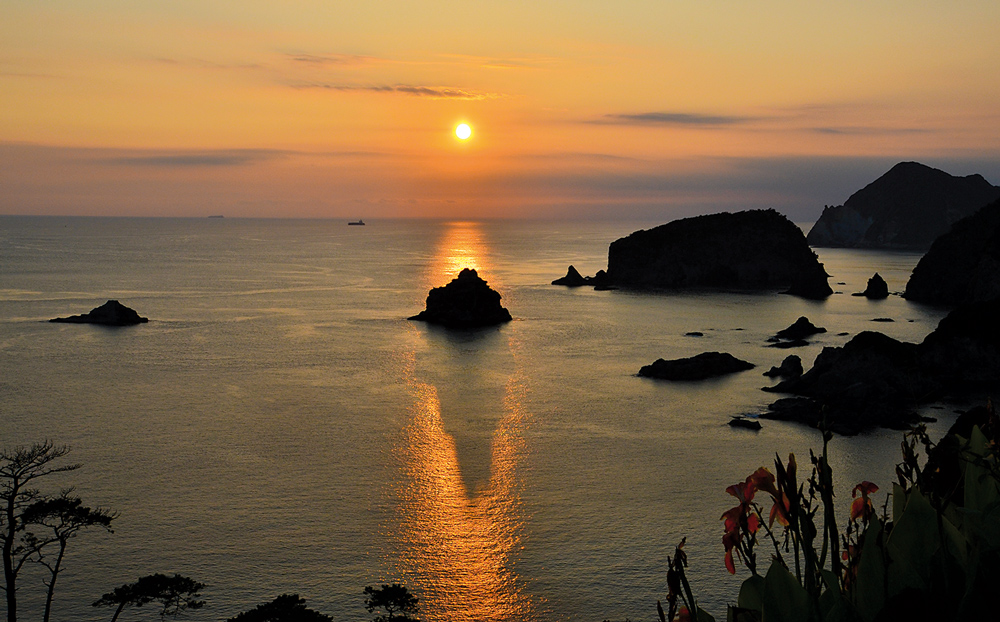
Sunset in paradise.
But according to Yuko, who has also worked as a tourist guide, the most beautiful caves have to be visited by kayak. The Wonderful World team organises half-day trips to discover the sandstone caves of the Mera Bay, which are accessible only by sea. I joined a group of two other people for the excursion, which begins with a training course. equipped with pedals, the sea kayak is easy to steer, but you need a certain amount of skill to squeese through the narrow passages into the caves. “That’s good!” encourages the instructor. After 30 minutes bumping into the rocky walls, I am able finally to make my way into the large sandstone caves. Like a mini-amusement park, we weave in and out of the cave openings. Now and then we hear the cry of a bat or the beat of heron wings. The magmatic rock rising out of the emerald water is a wonderful sight, especially when after two laborious hours of rowing, we meet up in the water to explore the depths snorkelling. Depending on the time of year, you’ll come across electric-blue neon damselfish, elegant flounder fish and even squid. On the way back, I soak my limbs in the delightful Minatoyu hot spring next to the large beach at Yumigaoka, before retiring into the refreshing cool of the Wabi Sabi inn whose small tatami rooms overlook a patch of mountains filled with the song of cicadas.
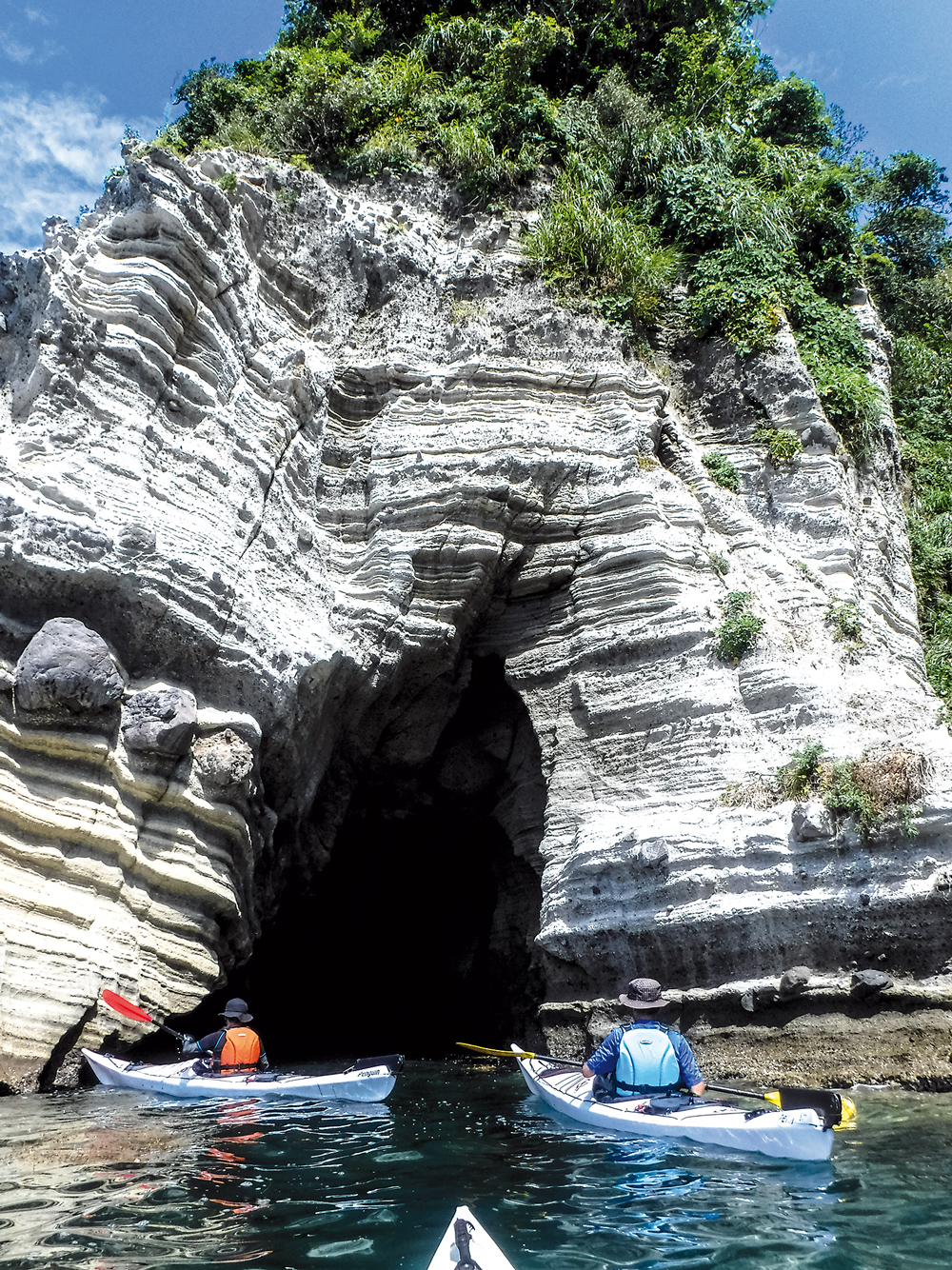
The caves in Mera Bay are only accessible by sea. Quite wonderful.
Late afternoon, kisami beach closes its bathing area and becomes calm again. kayaks breast the waves while people sitting comfortably in chairs reading are enjoying the last rays of the sun. On the beach, a group of American teenagers of Japanese origin play in the waves. There are many mixed couples speaking all different languages. “I, too, was charmed by kisami’s international feel,” explains Yumiko Crounch, a friend of Yuko’s. This Shikoku-born woman who used to work for Seibu Department Stores, travelled around the world with her english husband before coming to live in kisami.
“After London and Singapore, we finally settled here 8 years ago!” Since then, this mother has retired and spends her days cooking or driving her sports car. In a landscape worthy of a hitchcock film, the “Road Star” snakes along the coast among stunning scenery with rocky peaks emerging from the sea. We pass Cape Irozaki at the extreme tip of the peninsula to climb towards Cape Aiai. “from up there, you’ll see it’s just like Jurassic Park,” Yumiko informs me. We climb the last few metres on foot to reach the summit of Yusuge Park whose slopes were formed by the eruption of Nanzaki volcano 4,000,000 years ago. Covered in wild yusuge flowers, which bloom at dusk, the site has an ocean view that will take your breath away. The flaming sun sets and casts the mysterious shadow of the magmatic rocks onto the golden sea. In Japan, all the rocks at the entrance to forests or estuaries are considered to be sacred doorways, and the rocks of Izu formed by volcanic eruptions have their own mystical quality.
“You don’t believe me,” laughs Yuko, pouring us some sake from Shizuoka in her private bar, which faces a shrine. Like Yumiko, she worked in Paris and Tokyo before landing in kisami. She tells us a story. “When I was working at Tokuma Publishing in Tokyo, I often went to have a drink after work in a little local izakaya (bar),” she begins while preparing a delicious tuna tartare. “There was always an old man sitting at the bar having a drink. One day, I asked him what he did, and he told me he drew manga. To begin with, I didn’t pay much attention as I didn’t recognise his face, but afterwards I learned that it was MIYAzAkI hayao!” We looked at her openmouthed. “Years later, when I came to live in Izu, he told me ‘You’ve made a good choice. Many of my stories have been inspired by Izu’s landscape.’” I immediately thought back to the fantastic shapes of the tree-covered rocks floating in the sea, and exclaimed: “The Castle in the Sky!”
ALISSA DESCOTES-TOYOSAKI
TO GET THERE FROM TOKYO STATION,
take the JR Odoriko train, which provides a direct link to Shimoda taking under 3 hours. At Shimoda, catch one of the many buses to Kisami Ohama (The main beach at Kisama). The traditional inns, generally owned by elderly people, and the onsen (thermal springs) have not been open to tourists since the start of the Covid-19 epidemic. Be sure to check beforehand. Many other places remain open and offer accommodation including Ernest House, Oli Oli and Wabi Sabi. You can hire a bicycle, but beware of steep climbs!
in researching this story.

